Eumorpha intermedia
Eumorpha intermedia
you-MORE-fuhMin-ter-MEE-dee-uh
(B. P. Clark, 1917) Pholus
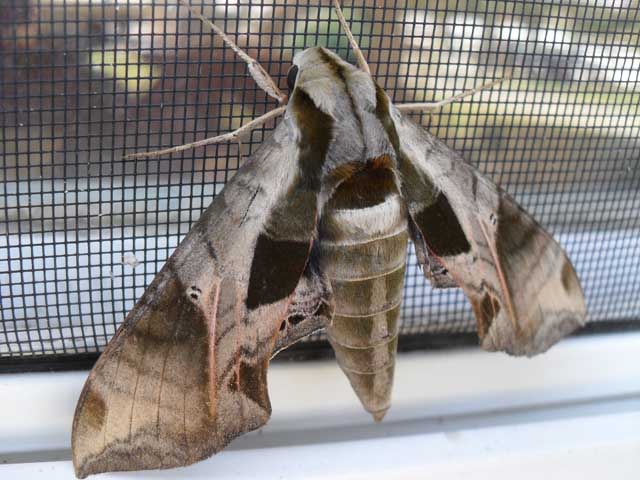
Eumorpha intermedia*, Jekyll Island, Glynn County, Georgia,
October 4, 2010, courtesy of Rebecca Deatsman,
blog at
http://rebeccainthewoods.wordpress.com/
id by Bill Oehlke, confirmed by James P. Tuttle.
This site has been created by
Bill Oehlke at oehlkew@islandtelecom.com
Comments, suggestions and/or additional information are welcomed by Bill.
| TAXONOMY:
Superfamily: Sphingoidea, Dyar, 1902
Family: Sphingidae, Latreille, 1802
Subfamily: Macroglossinae, Harris, 1839
Tribe: Philampelini, Burmeister
Genus: Eumorpha, Hubner, [1807]
Species: intermedia, (B. P. Clark, 1917) |
MIDI MUSIC
"What.A.Wonderful.World"
copyright C. Odenkirk
MIDI CITY
ON.OFF
<bgsound src="world.mid" LOOP=FOREVER>
|
DISTRIBUTION:
The Intermediate Sphinx Moth, (Eumorpha intermedia),
(Wing span: 3 9/16 - 3 7/8 inches (9 - 9.8 cm)), flies in lower austral and subtropical lowlands in North Carolina, Georgia, Florida,
Mississippi, Louisiana, and South Texas.
Forewing length of males is 38-41mm and of females is 43-47mm while that of E. pandorus is about 10% larger.
Eumorpha intermdia is the smallest of the three Eumorpha found in USA. (VAB)
Vernon A. Brou writes, "Noted your page on Eumorpha intermedia has a number of adults illustrated in addition to the male and
female I long ago provided to you. Well the only adult intermedia on that page are my two specimens. All Georgia images on this intermedia page
(marked by *), are E. pandorus. The upper two images are two shots of the same one Georgia specimen.
"In this E-mail I have provided you with a jpg of a fresh example of a female intermedia which has an olive green in color tinge over the entire upper surface.
Once intermedia are pinned and dried, the olive green coloration disappears, which is why my earlier pinned specimens are brown in appearance.
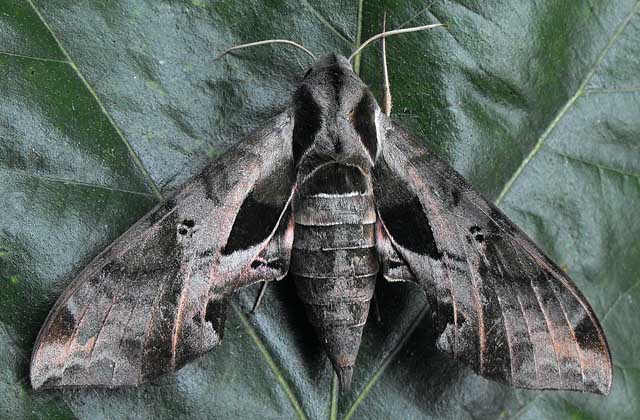
Eumorpha intermedia female, Louisiana,
courtesy of Vernon A. Brou.
"The distal edge of the large median patch near the inner margin of the dorsal side of the forewings of the three Eumorpha species illustrated in Fig.1, of my
publication here:
http://www.academia.edu/1509724/Second_addendum_to_the_Sphingidae_of_Louisiana
are a helpful diagnostic in distinguishing the three similar species of Eumorpha in the US and Canada; concave in satellitia, convex in intermedia,
and somewhat straight in pandorus."
I (Bill Oehlke) do see a consistent difference in the outer edge of the dark median patch that Vernon mentions.
I agree that the outer edge is inwardly concave in satellitia, but this same outer edge appears straight to me in both pandorus and intermedia,
The consistent difference that I see between intermedia and pandorus regarding this outer edge is that it meets the inner margin at an angle around 40
degrees in intermedia, while in pandorus the same outer edge meets the inner margin at an angle of over 50 degrees, or the line of the outer edge is more oblique in
intermedia. This character is much more easily recognized in images of spread specimens.
If one holds a square corner of a piece of paper so that the lower edge of the paper follows the inner edge of the inner margin of the right forewing,
and the upward line of the paper forms a ninety degree angle at the "continued-line" of intersection between the inner margin and the outer edge of the
dark median patch, one can see that the angle of intersection between the outer continuation of the inner margin and the edge of the dark patch is less than
45 degrees (probably about 40 degrees) in intermedia and more than 45 degrees
(probably 55-60 degrees) in pandorus. If I had a protractor available, I would actually do the measuring. (Bill Oehlke)
Applying, my own description, above, I agree with Vernon that the three Georgia specimen images are of E. pandorus.
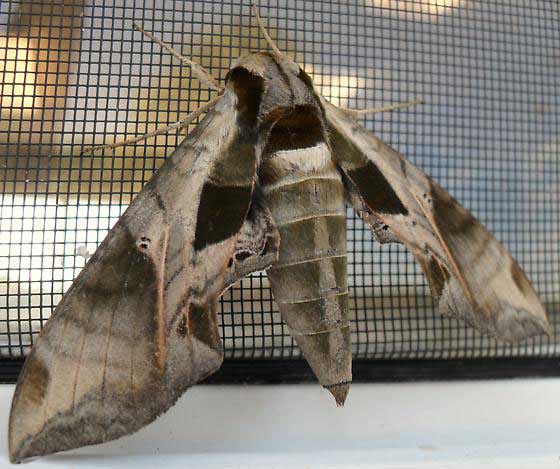
Eumorpha intermedia*, Jekyll Island, Glynn County, Georgia,
October 4, 2010, courtesy of Rebecca Deatsman,
blog at
http://rebeccainthewoods.wordpress.com/
id by Bill Oehlke, confirmed by James P. Tuttle.
A less diagnostic feature is the scalloped subterminal line near forewing apex. In very similar Eumorpha pandorus the same line is only slightly wavy,
definitely not scalloped.
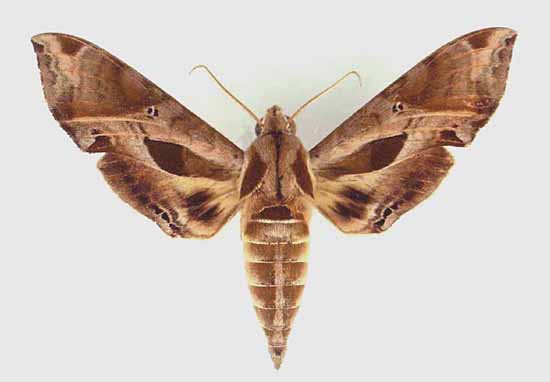
Eumorpha intermedia male courtesy of Vernon A. Brou.
FLIGHT TIMES AND PREFERRED FOOD PLANTS:
Eumorpha intermedia adults are on the wing
from April-October.
Adults nectar at various flowers in the dark.
Eumorpha intermedia larvae feed upon peppervine, Ampelopsis arborea. Possibly they will also accept grape (Vitis species),
but so far no records of that host have been reported to my knowledge.
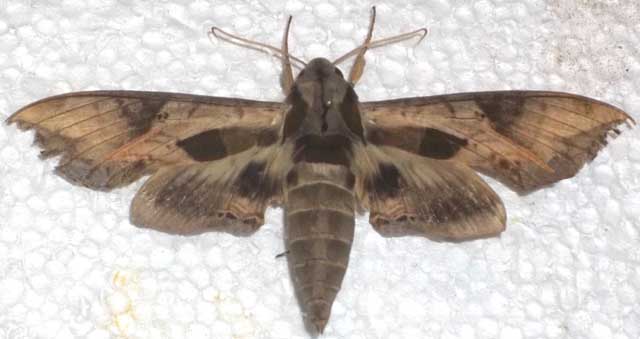
Eumorpha intermedia*, September 30, 2011, courtesy Rev. Redmond Farrier,
(tentative id & digital repair by Bill Oehlke, possibly wind assisted stray, usually more easterly in GA).
Vernon A. Brou has indicated that all those images marked by * are really Eumorpha pandorus.
Vernon has provided the following original description of Eumorpha intermedia.
ECLOSION, SCENTING AND MATING:
Pupae wiggle to surface just prior to eclosion.
Females call at night, and males fly into the wind to pick up and track the pheromone plume.
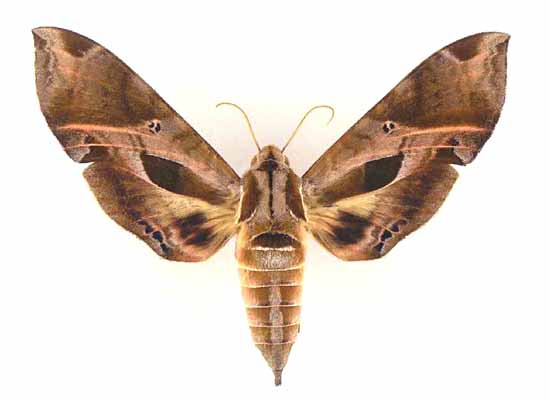 Eumorpha intermedia female courtesy of Vernon A. Brou.
EGGS, LARVAE AND PUPAE:Larvae pupate in shallow underground chambers.
The white, oblique side panels are greatly reduced on all abdominal segments except six and seven.
There are both green and red-brown forms.
Long white horn with black tip is not present for final instar.
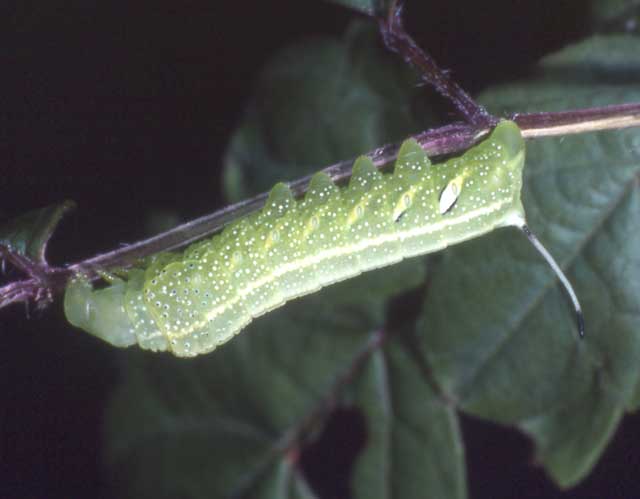
Eumorpha intermedia third instar molting, Baton Rouge, East Baton Rouge Parish, Louisiana,
courtesy of James P. Tuttle.
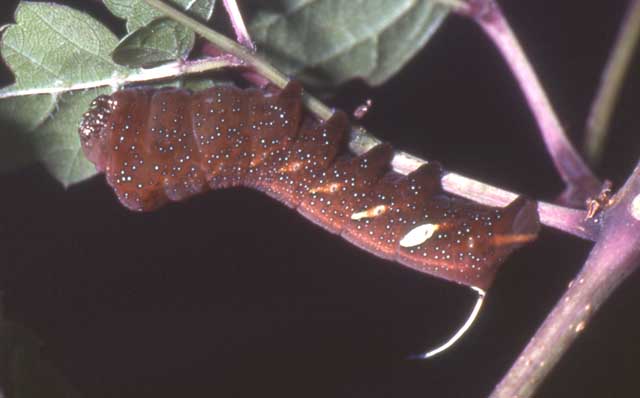
Eumorpha intermedia fourth instar, Baton Rouge, East Baton Rouge Parish, Louisiana,
courtesy of James P. Tuttle.
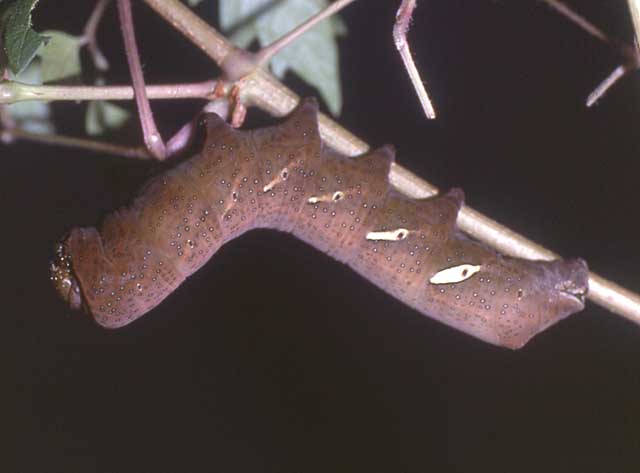
Eumorpha intermedia fifth instar, Baton Rouge, East Baton Rouge Parish, Louisiana,
courtesy of James P. Tuttle.
Larvae like to remain well hidden deep within tangle of vines.
Larval Food Plants
Listed below are primary food plant(s) and alternate food plants. It is hoped that this
alphabetical listing followed by the common name of the foodplant will
prove useful. The list is not exhaustive. Experimenting with closely
related foodplants is worthwhile.
Ampelopsis arborea .......
| Peppervine
|
Return to U. S. A. Table
Return to Philampelini Index
Return to Sphingidae Index
|








